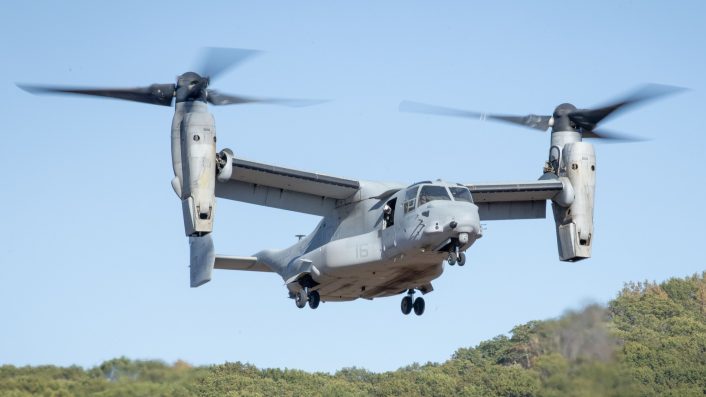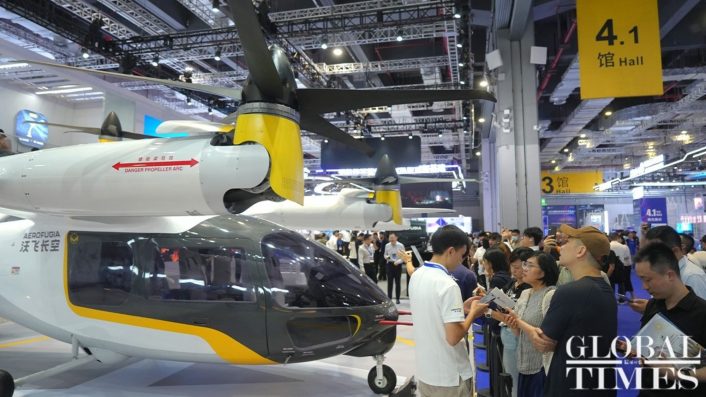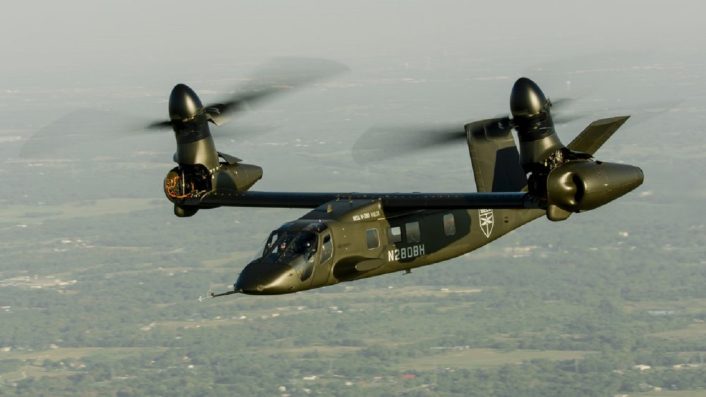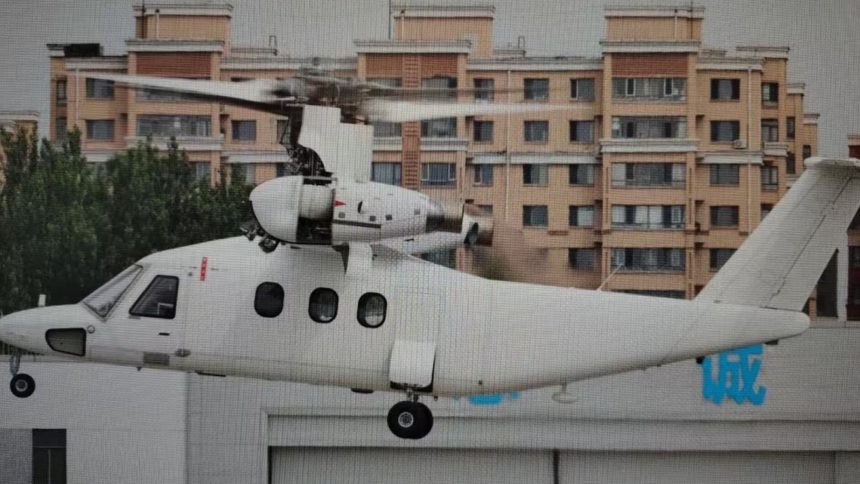The aircraft currently appears to be purely civilian passenger oriented, but it could have military applications in future.
An image has emerged showing China’s first crewed tiltrotor aircraft taking flight. Leading Chinese military aviation researcher Andreas Rupprecht said this was a tiltrotor prototype captured during its maiden flight, while also sharing a picture of a small-scale model of the same aircraft at an exhibition stall.
The aircraft is similar in configuration to the Bell V-280 Valor with only the prop-rotor pivoting forward instead of the entire engine nacelle, like the V-22 Osprey or the Leonardo AW609. Engineering-wise this is a simpler proposition, reducing the technical complexity both in manufacturing, maintenance and repairs.
In fact, tiltrotors like the V-22 Osprey have a troubled history in the U.S. Marine Corps and U.S. Air Force service. The U.S. Army’s future MV-75, part of the FLRAA (Future Long-Range Assault Aircraft) program, will be based on the V-280.
The flight of this manned tiltrotor also comes after the first such Chinese unmanned tiltrotor, identified as UR6000, broke cover in mid-October 2024 at the facility of Wuhu United Aircraft in eastern China’s Anhui province. It is not clear whether both these aircraft would be displayed during the upcoming Sep. 3 Victory Day parade, or whether they would have a future military use.
Another surprise … apparently a tiltrotor prototype performed its maiden flight.
(Image via @Captain小潇 from Weibo) pic.twitter.com/mkT0PNESxG
— @Rupprecht_A (@RupprechtDeino) August 18, 2025
Unconfirmed posts on Telegram, based on information shared on Sina Weibo and WeChat, identify the developer of the new tiltrotor as Hafei Aviation Industry, a subsidiary of Harbin Aircraft Industry Group (HAIG). However, its civilian commercial goals are clear, given that small mock-ups appeared in exhibitions, and it also has a market within China, considering Beijing’s thrust on urban mobility, transportation and connecting remote regions.
???
Sure, why not at this point.
Via Captain小潇 pic.twitter.com/t9KX7WBUim
— Rick Joe (@RickJoe_PLA) August 18, 2025
The tiltrotor aircraft
The image of the unidentified tiltrotor appears to be a shot off a screen, taken from a video of the aircraft during flight testing. At this stage, testing might involve basic lift-off, hover and flight control system checks, before being tested in more expansive envelopes.
The design is very similar to the small-scale model, with three passenger cabin windows on each side. This could mean the aircraft has been specifically developed for a massive market within China to have the capability for its burgeoning cities and suburbs.

The aircraft has a ‘high T-tail’ configuration and access doors in the front to enter the cockpit and the rear cabin for the passengers. Based on the design, it appears that it is meant to carry anywhere between six to twelve persons. The only difference between the flying example and the scale model is that the prop-rotor is encased in a shroud covering the rotor hub.
The aircraft has a tricycle landing gear, with what appears to be a single wheel on each unit. Another image of the aircraft from inside a hangar shows a second aircraft behind one that has its wing’s panels missing and the inner wiring and cabling clearly visible. Any flight data probe, usually attached on the nose, is not visible.
機首形状は模型に近いと言われればそうだがZ-9を彷彿とさせる。
中国には民間企業が開発している大型ティルトローターUAVのR6000なんかもあり、こちらも初飛行を間近に控えているが中国初の称号は結局609所が取ったか。
(image via wb/Oneninety)https://t.co/b3yTU1OWRB
— お砂糖wsnbn (@sugar_wsnbn) August 18, 2025
We do not know if the PLA (People’s Liberation Army) has already evinced interest in the type for troop insertion, extraction and logistical roles. Those missions however need a larger aircraft with bigger engines, and the Chinese tiltrotor here is evidently much smaller in size, although it would still have applications because of the tiltrotor’s range advantage compared to helicopters.
Hafei’s parent company HAIG is the developer of China’s frontline military helicopters, including the Z-9, Z-20 and Z-19. So, a future militarized derivative with larger turboshaft engines, self-protection defensive suites and the requisite avionics cannot be ruled out.
Other tiltrotors
The UR6000 unmanned tiltrotor, which was first unveiled at the Singapore Air Show in February 2024 as a conceptual model, broke cover in an image eight months later on Oct. 11 at the Wuhu United Aircraft’s facility as a completed example. According to Janes, United Aircraft calls it a “fully autonomous platform being designed for cargo and passenger transport applications.”
Janes, quoting company officials, added that the UR6000 has a maximum take-off weight of 6,100 kg, a commercial payload carrying capability of 2,000 kg, a cruise speed of 550 km/h, a service ceiling of 7,620 m, and can cover a maximum flight distance of 1,500 km.

Another smaller tiltrotor, an eVTOL (electric Vertical Take-Off Landing) called AE200 by Chinese company Aerofugia, was unveiled in July 2025 at China’s inaugural International Advanced Air Mobility Expo at Shanghai. Global Times quoted Aerofugia officials who said the company has “completed all test items related to tiltrotor transition flights.”
Following “manned test flights”, it would complete the last of the five-stage airworthiness certification stage required for passenger eVTOLs by 2026. Both the UR6000 and the AE200 have only the prop-rotor tilting forward and upward instead of the entire engine, like the Valor.
Future
It must be noted that the PLA Navy’s blue water and expeditionary goals currently encompass only its offshore reclaimed island bases in the northern and southern South China Sea along the ‘Nine Dash Line’ and deeper in the western Pacific a little beyond Taiwan to deter the United States.
Its existing naval, merchant marine, and civilian and military airlift capability comfortably allows logistically supporting these deployments. Thus, Beijing does not presently find a pressing need for a fast-moving tiltrotor to move troops and material to its islands.

Put differently, the absence of a tiltrotor transport does not affect PLA commanders’ and the CMC (Central Military Commission) calculus at all. Things however may still change if China decides to expand its blue water operations.
Harbin might nevertheless pitch this aircraft for the offshore energy sector, which needs ferrying men and materials to oil rigs. We can closely watch Beijing’s future energy policy in the SCS where it has contesting claims with Vietnam, Philippines, Malaysia, Taiwan and Brunei.
The possibility that CNOOC (China National Offshore Corporation), Sinopec (China Petroleum and Energy Corporation) and CNPC (China National Petroleum Corporation) decide to acquire this helicopter sometime in the future cannot be discarded. Targeting other developing countries looking for cheaper alternatives to Western aircraft, with non-Dollar loans and financing by Chinese banks as a part of its Belt and Road Initiative (BRI), would also be on the cards.









